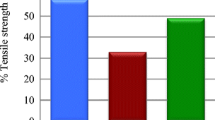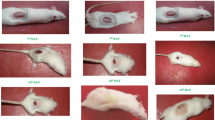Abstract
Growth factors and cytokines are key regulators of the wound-healing process. Epidermal growth factor (EGF) plays a vital role during the process of wound healing. There are limited numbers of studies related to EGF implantation effects on oxidative stress in oral wound healing. The objective of this study was to investigate the effect of EGF on myeloperoxidase (MPO) activity and nonenzymatic antioxidant levels of oral wound tissue on different days. In this study, New Zealand male albino rabbits were used. After submucosal incisions, the rabbits were divided into two equal groups: untreated wounds, and EGF-implanted wounds. The levels of glutathione (GSH), ascorbic acid (AA), and MPO activity were measured spectrophotometrically. As a result, MPO activity of oral wound tissue strips was increased by exogenous EGF treatment compared with controls. In addition, GSH and AA levels of oral wound tissue strips were not changed during oral wound-healing phases for both controls and experimental groups.
Similar content being viewed by others
References
Akbulut KG, Gönül B, Türkyılmaz A, Çelebi N (2002) The role of epidermal growth factor formulation on stress ulcer healing of the gastric mucosa. Surg Today 32:880–883. doi:10.1007/s005950200171
Aykaç AG, Uysal M, Yalçın AS, Koçak-Toker N, Sivas A, Öz H (1985) The effect of chronic ethanol ingestion on hepatic lipid peroxidase, glutathione, glutathione peroxidase and glutathione transferase in rats. Toxicology 36:71–76. doi:10.1016/0300-483X(85)90008-3
Barrandon Y, Green H (1987) Cell migration is essential for sustained growth of keratinocyte colonies: the roles of transforming growth factor-alpha and epidermal growth factor. Cell 50:1131–1137. doi:10.1016/0092-8674(87)90179-6
Berger J, Shepart D, Morrow F, Taylor A (1989) Relationship between dietary intake and tissue levels reduced and total vitamin C in nonscorbutic guinea pig. J Nutr 119(5):734–740
Beyer RE (1994) The role of ascorbate in antioxidant protection of biomembranes: interaction with vitamin E and coenzyme Q. J Bioenerg Biomembr 26:349–358. doi:10.1007/BF00762775
Çelebi N, Türkyılmaz A, Gönül B, Özoğul C (2002) Effects of EGF microemulsion formulation on the healing of stress-induced gastric ulcers in rats. J Control Release 83:197–210. doi:10.1016/S0168-3659(02)00198-0
Cohen S (1962) Isolation of a mouse submaxillary gland protein accelerating incisor eruption and eyelid opening in newborn animals. J Biochem 237:1555–1562
Coşkun Ş, Karataş F, Acartürk F, Olmuş H, Selvi M, Erbaş D (2005a) The effect of L-NAME administration after oral mucosal incision on wound NO level in rabbit. Mol Cell Biochem 278:65–69. doi:10.1007/s11010-005-6628-6
Coşkun Ş, Gönül B, Acartürk F, Take G, Erdoğan D (2005b) The effect of EGF PEG bead implantation in oral mucosal wound on the rabbit salivary glands trace element levels and EGF receptor immunoreactivity. FABAD J Pharm Sci 30:56–63
Coşkun Ş, Güleç EG, Balabanlı B, Acartürk F (2007) Effects of epidermal growth factor on lipid peroxidation and nitric oxide levels in oral mucosal ulcer healing: a time–course study. Surg Today 37:570–574. doi:10.1007/s00595-006-3455-7
Davies KJ (1995) Oxidative stress: the paradox of aerobic life. Biochem Soc Symp 61:1–31
Deutsch JC (1998) Ascorbic acid oxidation by hydrogen peroxide. Anal Biochem 255:1–7. doi:10.1006/abio.1997.2293
Di Paola R, Marzocco E, Mazzon E, Dattola F, Rotondo F, Britti D, De Majo M, Genovese T, Cuzzocrea S (2004) Effects of aminoguanidine in ligature-induced periodontitis in rats. J Dent Res 83:343–348. doi:10.1177/154405910408300414
Egéa JC, Hirtz C, Valcarcel J, Deville De Periere D (2005) Epidermal growth factor: a probable oral and digestive health protector. Pathologie-Biologie 50(10):608–612
Fujisawa K, Youji M, Masaru N (2003) Basic fibroblast growth factor and epidermal growth factor reverse impaired ulcer healing of the rabbit oral mucosa. J Oral Pathol Med 32:358–366. doi:10.1034/j.1600-0714.2003.t01-1-00111.x
Glowick SP, Kaplan SD (1955) Methods in enzymology. Academic Press, New York, pp 769–782
Gönül B, Karataş F, Özoğul C, Gelir E, Acartürk F (2003) Epidermal büyüme faktörünün tavşanda titanyum yerleştirilmiş ağız mukoza yaralarının iyileşmesine etkisi. Effects of epidermal growth factor on titanium implanted oral mucosal wound healing in the rabbit. Gazi Med J 14:97–102
Gönül B, Akbulut KG, Özer Ç, Yetkin G, Çelebi N (2004) The role of transforming growth factor alpha formulation on aspirin-induced ulcer healing and oxidant stress in the gastric mucosa. Surg Today 34:1035–1040. doi:10.1007/s00595-004-2856-8
Gope R (2002) The effect of epidermal growth factor and platelet-derived growth factors on wound healing process. Indian J Med Res 116:201–206
Hackam DJ, Henri RF (2002) Cellular, biochemical and clinical aspects of wound healing. Surg Infect (Larchmt) 3:23–35. doi:10.1089/10962960260496316
Halliwell B (1994) Free radicals, antioxidants, and human disease: curiosity, cause, or consequence? Lancet 344:721–724. doi:10.1016/S0140-6736(94)92211-X
Halliwell B, Wasil M, Grootveld M (1987) Biological significant scavenging of the myeloperoxidase-derived oxidant hypochlorous acid by ascorbic acid. FEBS Lett 213:15–18. doi:10.1016/0014-5793(87)81456-4
Jahovic N, Güzel E, Arbak S, Yeğen BÇ (2004) The healing-promoting effect of saliva on skin burn is mediated by epidermal growth factor: role of the neutrophils. Burns 30:531–538. doi:10.1016/j.burns.2004.02.007
Krawisz JE, Sharon P, Stenson WF (1984) Quantitative assay for acute intestinal inflammation based on myeloperoxidase activity. Gastroenterology 87:1344–1350
Lee RH, Efron D, Tantry U, Barbul A (2001) Nitric oxide in healing wound. A time course study. Exp Dermatol 11:189–202
Morris-Wiman J, Sego R, Brinkley L, Dolce C (2000) The effects of sialoadenectomy and exogenous EGF on taste bud morphology and maintenance. Chem Senses 25:9–19. doi:10.1093/chemse/25.1.9
Noctor G, Foyer CH (1998) Ascorbate and glutathione: Keeping active oxygen under control. Annu Rev Plant Physiol Plant Mol Biol 49:249–279. doi:10.1146/annurev.arplant.49.1.249
Noctor G, Gomez L, Vanacker H, Foyer CH (2002) Interactions between biosynthesis, compartmentation and transport in the control of glutathione homeostasis and signalling. J Exp Bot 53:1283–1304. doi:10.1093/jexbot/53.372.1283
Sakallıoğlu U, Aliyev E, Eren Z, Akşimşek G, Keskiner İ, Yavuz Ü (2005) Reactive oxygen species scavenging activity during periodontal mucoperiosteal healing: an experimental study in dogs. Arch Oral Biol 50:1040–1046. doi:10.1016/j.archoralbio.2005.03.012
Salvemini D, Mazzon E, Dugo L, Riley DP, Serraino I, Caputi AP et al (2001) Pharmacological manipulation of the inflammatory cascade by superoxide dismutase mimetic, M40403. Br J Pharmacol 132:815–827. doi:10.1038/sj.bjp.0703841
Som S, Raha C, Chattarjee IB (1983) Ascorbic acid: a scavenger of superoxide radical. Acta Vitaminol Enzymol 5:243–250
Stanbro WD (1998) A kinetic model of the myeloperoxidase-hydrogen peroxide-chloride ion system in phagolysosomes. J Theor Biol 193:59–68. doi:10.1006/jtbi.1998.0686
Steed DL (1998) Modifying the wound healing response with exogenous growth factors. Clin Plast Surg 25:397–405
Steiling H, Munz B, Werner S, Brauchle M (1999) Different types of ROS-scavenging enzymes are expressed during cutaneous wound repair. Exp Cell Res 247:484–494. doi:10.1006/excr.1998.4366
Weiss SJ, Ward PA (1982) Immune complex-induced generation of oxygen metabolites by human neutrophils. J Immunol 129:309–319
Winkler BS, Orselli SM, Rex TS (1994) The redox couple between glutathione and ascorbic acid: a chemical and physiological perspective. Free Radic Biol Med 17:333–349. doi:10.1016/0891-5849(94)90019-1
Acknowledgement
This investigation was supported by the Gazi University Research Foundation. Ankara, Turkey (BAP 05/2003-24).
Author information
Authors and Affiliations
Corresponding author
Rights and permissions
About this article
Cite this article
Güleç Peker, E.G., Coşkun, Ş., Ebegil, M. et al. Effect of exogenous epidermal growth factor (EGF) on nonenzymatic antioxidant capacities and MPO activity of wound tissue. Med Chem Res 19, 533–540 (2010). https://doi.org/10.1007/s00044-009-9210-z
Received:
Accepted:
Published:
Issue Date:
DOI: https://doi.org/10.1007/s00044-009-9210-z




